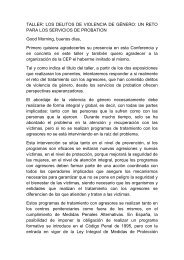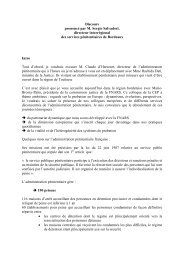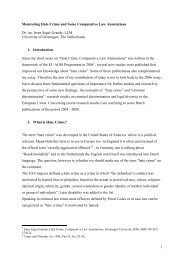Chapter 2 Austria - CEP, the European Organisation for Probation
Chapter 2 Austria - CEP, the European Organisation for Probation
Chapter 2 Austria - CEP, the European Organisation for Probation
You also want an ePaper? Increase the reach of your titles
YUMPU automatically turns print PDFs into web optimized ePapers that Google loves.
<strong>Chapter</strong> 2<strong>Austria</strong>Christoph Koss
1 HISTORICAL DEVELOPMENT OF THE PROBATION SERVICESYSTEM1.1 The start of <strong>the</strong> probation services in <strong>Austria</strong>The Association NEUSTART - <strong>Probation</strong>, Mediation, Social Work (“Verein -NEUSTART Bewährungshilfe Konfliktregelung, Soziale Arbeit”) or justNEUSTART underwent major changes in <strong>the</strong> year 2001, with a re<strong>for</strong>m of <strong>the</strong>structure of <strong>the</strong> organization, a new logo and <strong>the</strong> new name NEUSTART(<strong>for</strong>merly VBSA, Association <strong>for</strong> probation services and social work). This newname was necessary because <strong>the</strong> clients were not only suspects or offenders anymore but also victims.Currently, NEUSTART works with 600 employees and 780 volunteers in 14agencies, making it one of <strong>the</strong> largest job providers in <strong>the</strong> field of social work in<strong>Austria</strong>. Fur<strong>the</strong>rmore, in 2004 NEUSTART won a <strong>European</strong> bid to lead <strong>the</strong>probation service, court support and, to a limited extent, mediation in penalmatters in certain project areas in Baden -Württemberg, Germany. For Europe,such a contract with a non-profit association is unique. After finishing <strong>the</strong> projectsuccessfully by <strong>the</strong> end of 2006, NEUSTART was awarded <strong>the</strong> contract <strong>for</strong> <strong>the</strong>whole Land of Baden–Württemberg and a subsidiary is now in charge to do <strong>the</strong>work. What is today a private association with innumerable tasks and objectives,started out as a private initiative in 1957. In <strong>the</strong> 1950s probation servicesconsisted virtually only of supporting persons released from custody withdonations of money or goods. During those years <strong>the</strong>re was a marked increase injuvenile delinquency. The only alternative to custodial sentences and <strong>the</strong>irexecution at <strong>the</strong> time was <strong>the</strong> so-called protective supervision (Schutzaufsicht),which dated back to 1920 and was ra<strong>the</strong>r ineffective. The experience made by <strong>the</strong>probation systems in o<strong>the</strong>r countries began to be increasingly discussed in<strong>Austria</strong>, particularly in legal circles and among psychologists. One event inparticular, a riot of juveniles in 1952, in a closed institution established <strong>for</strong>youngsters with problematic behaviour, provided <strong>the</strong> impetus to look <strong>for</strong>alternatives to such camps. In 1955 a judge in <strong>the</strong> Tyrol was <strong>the</strong> first to supervisea juvenile along probationary lines. Judges at juvenile courts called <strong>for</strong> <strong>the</strong>introduction of probation services. The Task Force <strong>for</strong> <strong>Probation</strong> Services(Arbeitsgemeinschaft für Bewährungshilfe) was founded in 1957 and eventuallydeveloped into <strong>the</strong> above-mentioned Verein für Bewährungshilfe und SozialeArbeit (VBSA). In 2001 this name was changed to NEUSTART - BewährungshilfeKonfliktregelung, Soziale Arbeit.1.2 Important developmentsThe first important milestone in <strong>the</strong> development of <strong>the</strong> probation service systemwas <strong>the</strong> Juvenile Court Act (Jugendgerichtsgesetz) of 1961. This Act took intoconsideration all <strong>the</strong> experiences ga<strong>the</strong>red by <strong>the</strong> members of <strong>the</strong> Task Force,who, with one exception, were all volunteers. The probation system started tooperate on its own law. The general political attitude towards crime at <strong>the</strong> timewas not a particularly liberal one. But a highly committed minister of justice (Dr.Christian Broda, who implemented many major re<strong>for</strong>ms and had a decisive
impact <strong>for</strong> many years, not only on <strong>the</strong> probation system) was able to win <strong>the</strong>support of all political parties <strong>for</strong> this new law.
1.2.1 Chronology of fur<strong>the</strong>r developments- 1964: implementation of probation was entrusted to <strong>the</strong>, as it was <strong>the</strong>n called,Association <strong>for</strong> probation and social youth work (Verein für Bewährungshilfe undsoziale Jugendarbeit). Special emphasis was placed on <strong>the</strong> development ofprobation services in <strong>the</strong> federal provinces (Bundesländer) of <strong>Austria</strong>.- 1969: <strong>the</strong> <strong>Probation</strong> Services Act (Bewährungshilfegesetz) was passed. Itprovided a legal and organizational framework and detailed <strong>the</strong> responsibilities,rights and obligations of probation workers.- 1975: a comprehensive criminal law re<strong>for</strong>m accompanied <strong>the</strong> modernising ofsociety as a whole. Among o<strong>the</strong>r modifications probation services were extendedto adults. As a consequence, <strong>the</strong> association changed its name to Verein fürBewährungshilfe und Soziale Arbeit (VBSA). It extended its services byestablishing central agencies <strong>for</strong> aftercare. These were open to all personsreleased from custody. Fur<strong>the</strong>rmore <strong>the</strong> provision of assisted housing offered <strong>the</strong>possibility to open new places to stay <strong>for</strong> different groups of offenders and thusbroaden <strong>the</strong> services offered.- 1980 amendment of <strong>the</strong> <strong>Probation</strong> Services Act brought an end to discussionson nationalization (see below) of <strong>the</strong> VBSA. Up to this amendment severalopinions and some support existed within <strong>the</strong> Ministry of Justice to establish likein o<strong>the</strong>r countries a public probation system.- 1988: a new Juvenile Court Act was passed which, among o<strong>the</strong>r provisions,provided <strong>the</strong> legislative basis <strong>for</strong> mediation in penal matters <strong>for</strong> juveniles.- 1991: <strong>the</strong> start of comprehensive structural re<strong>for</strong>ms of <strong>the</strong> VBSA with <strong>the</strong> aim ofputting <strong>the</strong> VBSA in a position to implement its mandates on a contractual basis.The position of <strong>the</strong> VBSA was that <strong>the</strong> probation system and o<strong>the</strong>r servicesshould be carried out by a private non profit organization. In reality this wasalready <strong>the</strong> case in <strong>Austria</strong> since <strong>the</strong> existence of <strong>the</strong> VBSA, but <strong>the</strong> politicalsystem never made a final decision with all its necessary consequences. There<strong>for</strong>ea working group with <strong>the</strong> participation of <strong>the</strong> Ministry of Justice developedsuggestions <strong>for</strong> <strong>the</strong> structure, <strong>the</strong> tasks and responsibilities of <strong>the</strong> VBSA as well as<strong>for</strong> a controlling and report system to <strong>the</strong> Ministry. Thus a clear basis <strong>for</strong> <strong>the</strong>relationship between <strong>the</strong> Ministry and <strong>the</strong> VBSA in <strong>the</strong> future should bedescribed.- 1994: <strong>the</strong> Federal Ministry of Justice and <strong>the</strong> VBSA entered into <strong>the</strong> GeneralContract (Generalvertrag), which states <strong>the</strong> obligations and competencies of <strong>the</strong>Federal Ministry of Justice as <strong>the</strong> purchaser and <strong>the</strong> VBSA as <strong>the</strong> provider ofservices. This marked <strong>the</strong> successful completion of <strong>the</strong> structural re<strong>for</strong>ms andfollowed <strong>the</strong> suggestions of <strong>the</strong> working group.- 1999: parliament passed <strong>the</strong> Act on Diversion Measures (Diversionsgesetz). Theprovince of Styria was integrated into <strong>the</strong> VBSA organization, which meant that<strong>the</strong> VBSA became responsible to provide its service in all parts (provinces) of<strong>Austria</strong>. 1 . Also in 1999 <strong>the</strong> VBSA started a project to support victims of severeoffences.1A detailed description of <strong>the</strong> history of VBSA between 1957 and 1989 is contained in <strong>the</strong>brochure “Probezeit”, see Index.
- 2001: a major re<strong>for</strong>m of <strong>the</strong> organization was carried out, which reduced <strong>the</strong>number of 42 agencies (Einrichtungen) in <strong>the</strong> nine provinces of <strong>Austria</strong> to 14.Management staff was also reduced significantly. The association changed alsoits name from VBSA to Association NEUSTART - <strong>Probation</strong>, Mediation, SocialWork (Verein NEUSTART-Bewährungshilfe Konfliktregelung, Soziale Arbeit, orjust NEUSTART). A new name was necessary since <strong>the</strong> clients had changed over<strong>the</strong> years. They were no longer just offenders but also victims of crime.- 2004: NEUSTART won a <strong>European</strong> bid to lead <strong>the</strong> probation service, courtsupport and, to a limited extent, mediation in penal matters in certain projectareas in Baden-Württemberg, Germany.- 2007: a new contract <strong>for</strong> <strong>the</strong> duration of 10 years stipulates that a subsidiary ofNEUSTART is in charge <strong>for</strong> all areas of Baden-Württemberg.1.2.2 Private - publicFor many years <strong>the</strong>re have been discussions on whe<strong>the</strong>r <strong>the</strong> probation servicesystem should be private or public. The political parties as well as <strong>the</strong> policymakerswithin NEUSTART kept changing <strong>the</strong>ir points of view. In 1969, <strong>for</strong>instance, <strong>the</strong> implementation through private associations was made part of <strong>the</strong><strong>Probation</strong> Services Act of 1969 and NEUSTART was entrusted with <strong>the</strong> mandate<strong>for</strong> its implementation. But this was only seen as a temporary provision untilestablishment of a public service. The advantages of a private probation service,however, in particular <strong>the</strong> relative independence of social work practice as well as<strong>the</strong> opportunity to test new activity fields in model projects and <strong>the</strong> flexibility torespond to changes of <strong>the</strong> criminal law or society needs, outweighed any o<strong>the</strong>r<strong>for</strong>ms by far. After it became clear that <strong>Austria</strong> was to join <strong>the</strong> <strong>European</strong> Union,<strong>the</strong> Ministry of Justice and <strong>the</strong> <strong>Austria</strong>n parliament decided to have probationservices provided by a private organization.In 1994 <strong>the</strong> General Contract between <strong>the</strong> Federal Ministry and NEUSTARTwas entered into <strong>for</strong>ce. This contract states that <strong>the</strong> Federal Ministry of Justice is<strong>the</strong> purchaser and NEUSTART is <strong>the</strong> provider of services and clearly definesresponsibilities and functions. Part of <strong>the</strong> contract are <strong>for</strong> example a catalogue ofall <strong>the</strong> services <strong>for</strong> which NEUSTART is paid <strong>for</strong> by <strong>the</strong> Ministry, provisions <strong>for</strong> acontrolling and reporting system, <strong>the</strong> duration of <strong>the</strong> contract and how to dealwith certain circumstances which might occur in <strong>the</strong> future like <strong>the</strong> closure ofNEUSTART. Important is also a list of decisions which have to be agreed by <strong>the</strong>Ministry in advance or where it has a right to veto.1.2.3 Professional – volunteerThe Juvenile Court Act of 1961 had provided <strong>for</strong> volunteer probation workersonly. But it soon became clear that professional social workers with adequatetraining were needed. Never<strong>the</strong>less volunteers are still carrying out part of <strong>the</strong>work today. They are simply indispensable. Professional staff of NEUSTARTincludes social workers engaged in all fields of activities, which NEUSTART is incharge of. Volunteer work is only done in <strong>the</strong> area of probation. It requiresstandards like recruitment, training, and selection of eligible cases, supervisionby professional staff and a limitation of caseload from between one to five cases.
With some exceptions (sexual offenders and clients with multi problems areexcluded) voluntary staff does <strong>the</strong> same probation work as professionals.
1.2.4 One national organization - a number of decentralizedassociationsToday, we take it as logical and self-evident that statutory probation services areper<strong>for</strong>med by a single organization throughout <strong>Austria</strong>, a system that providesmany advantages, such as a uni<strong>for</strong>m, high professional standard, or considerableweight in crime policy. But first, in 1968, <strong>the</strong> Constitutional Court(Verfassungsgerichtshof) was called upon to rule whe<strong>the</strong>r probation fell under<strong>the</strong> jurisdiction of <strong>the</strong> federal government or of <strong>the</strong> provinces. According to <strong>the</strong>Court’s decision, probation falls under <strong>the</strong> jurisdiction of <strong>the</strong> federal government.There<strong>for</strong>e <strong>the</strong> Ministry of Justice is responsible <strong>for</strong> probation service and not <strong>the</strong>nine provinces of <strong>Austria</strong>. After years of having two associations organising anddoing probation work, <strong>the</strong> Ministry decided in 1999 to contract only withNEUSTART as <strong>the</strong>ir single partner.1.2.5 Assistance <strong>for</strong> delinquents - repression and controlThe vision and mission of NEUSTART places support of offenders or victims in<strong>the</strong> centre of its tasks. There<strong>for</strong>e, most of <strong>the</strong> persons employed are socialworkers by profession. NEUSTART would not carry out services focusing oncontrol measures only. On <strong>the</strong> o<strong>the</strong>r hand it is obvious that <strong>the</strong> notion of aprobation service not only includes assistance but also an element of control.1.3 <strong>Probation</strong> activities in a nutshellIn <strong>Austria</strong> <strong>the</strong> court or <strong>the</strong> public prosecution orders probation activities. Thecourt orders that probation services are provided when a delinquent is given aconditional sentence (bedingte Verurteilung) or a conditional release (bedingteEntlassung). Public prosecutors may order probation activities until <strong>the</strong>beginning of <strong>the</strong> trial phase, provided that <strong>the</strong> client consents. Most of <strong>the</strong>probation activities comprise assistance to individuals; however, group work isalso possible. Specific standards in support programmes are compulsory <strong>for</strong>certain target groups (defrauders, refugees, stalkers, drug addicts etc.). Violentoffenders are enrolled in anti-violence training.Every probation activity starts with a detailed case history. It <strong>for</strong>ms <strong>the</strong> basis<strong>for</strong> <strong>the</strong> choice of support programme and <strong>the</strong> focal points in support work.Support activities are planned in <strong>the</strong> <strong>for</strong>m of work concepts with support goalsand stages of work, which are continuously reviewed. NEUSTART is not only incharge of probation activities throughout <strong>Austria</strong> but also carries out <strong>the</strong>following o<strong>the</strong>r socially constructive measures in penal matters:- mediation in penal matters (Außergerichtlicher Tatausgleich or short ATA) <strong>for</strong>compensation between offender and victim (Act on Diversion Measures; <strong>for</strong>juveniles since 1985, <strong>for</strong> adults since 1992);- acting as an intermediary <strong>for</strong> community service (Gemeinnützige Arbeit)under <strong>the</strong> Diversion Act, since 2000;- aftercare (Haftentlassenenhilfe) offered to persons released from prison whoare not on probation (post-release aftercare) on a voluntary basis (since 1975)
- assisted housing (Wohnbetreuung) <strong>for</strong> clients of <strong>the</strong> probation service and <strong>the</strong>post-release aftercare service in two of <strong>the</strong> nine federal provinces (since 1975);- work training (Werkstätten) <strong>for</strong> clients of <strong>the</strong> probation service and <strong>the</strong> postreleaseaftercare service in two of <strong>the</strong> nine federal provinces;- victim support (Verbrechensopferhilfe) in three federal provinces (since1999);- trial support <strong>for</strong> victims (Prozessbegleitung) throughout <strong>Austria</strong> (since 2005).Currently, in two model projects, support by social workers to persons underelectronic monitoring (Elektronische Aufsicht) after a conditional release fromprison and intermediary activities in respect of community service as analternative to prison terms <strong>for</strong> people who fail to pay fines are being tested. Allservices of social workers are documented in a computer programme, which alsofurnishes data <strong>for</strong> statistical and qualitative surveys. All professional andvolunteer workers in 14 agencies in <strong>Austria</strong> do social work. The agencies aremanaged by Agency Heads; <strong>the</strong> Heads of Departments report to <strong>the</strong>se and in turnare in charge supervision of <strong>the</strong> professional workers. The volunteer probationofficers are organized in teams headed by professional and specially trainedprobation officers.2 LEGISLATIVE BASIS AND MISSION2.1 Legislative basisThe organization and provision of probation services in <strong>Austria</strong> is governed by<strong>the</strong> Federal <strong>Probation</strong> Services Act (PSA) of 27 March 1969 as amended byFederal Law Gazette I No. 113/2006 (Bundesgesetz über die Bewährungshilfe orBewHG, hereinafter referred to as PSA). In addition to sections on probationservices, <strong>the</strong> PSA also contains <strong>the</strong> following socially constructive measures:- <strong>the</strong> provision of housing <strong>for</strong> clients who do not have appropriateaccommodation, a fact which would jeopardise <strong>the</strong> success of probationmeasures (Section 13 PSA);- involvement of social workers in <strong>the</strong> diversion measures, i.e. mediation inpenal matters (ATA) and community service, as well as in education andtraining courses (Sections 29 to 29b PSA) and- aftercare (Section 29c PSA).On <strong>the</strong> basis of Section 24 PSA a General Contract was entered into, whereby <strong>the</strong>Republic of <strong>Austria</strong> delegated <strong>the</strong>se social-work duties to <strong>the</strong> associationNEUSTART. <strong>Probation</strong> as a measure of special prevention may as a matter ofprinciple be ordered <strong>for</strong> adults and juveniles (14 to 18 years of age) in <strong>the</strong>following context, whenever punishable acts are concerned:- when a prison sentence or preventive measure linked with imprisonment issuspended or when <strong>the</strong> convict is conditionally released from imprisonment(Section 50 Par. 1 of <strong>the</strong> <strong>Austria</strong>n Criminal Code (Strafgesetzbuch/StGB),hereinafter referred to as CC);- if a juvenile has been found guilty of a criminal act under reservation of apenalty or if <strong>the</strong> service of a prison term <strong>for</strong> a punishable act committed
e<strong>for</strong>e <strong>the</strong> perpetrator had turned 21 is postponed until <strong>the</strong> perpetrator hascompleted vocational education (Section 50 Par. 1a CC);- when a diversion measure has been ordered on probation (Section 90f of <strong>the</strong>Code of Criminal Procedure (Strafprozessordnung/StPO), hereinafter referredto as CCP);- when preliminary probation services are provided during criminalproceedings (Section 197 CCP);- when a criminal report has been filed but fur<strong>the</strong>r proceedings or charges aredropped or suspended temporary (Section 35 Suchtmittelgesetz/Act onAddictive Substances).Voluntary probation service is possible after an unconditional release fromprison or after <strong>the</strong> end of a probation period in which probation services wereprovided (Section 27a PSA). Diversion measures, i.e. ATA (mediation in penalmatters), community service and education or training courses are primarilyproposed by <strong>the</strong> public prosecution or <strong>the</strong> court, if- <strong>the</strong> facts of <strong>the</strong> case are sufficiently clear;- <strong>the</strong> punishable offence is dealt by a single judge and not a panel ofprofessional and lay judges, or a jury (usually when <strong>the</strong> maximum penaltydoes not exceed 5 years of imprisonment);- no serious fault is assumed;- <strong>the</strong> act did not result in loss of life;- a penalty instead of a diversion measure does not seem indicated with a viewto special or general prevention.Diversion measures require <strong>the</strong> consent of <strong>the</strong> suspect. Charges are dropped withfinal effect if <strong>the</strong> diversion measure was successful. Pursuant to Section 49a CCPvictims who could have been exposed to violence, a dangerous threat or animpairment of <strong>the</strong>ir sexual integrity are entitled to psychosocial and legal trialsupport (Prozessbegleitung). Also entitled are relatives of a person who waskilled. NEUSTART is one of <strong>the</strong> organizations in charge of trial support. In someprovinces NEUSTART also offers victim support that goes beyond trial support.2.2 Mission and mission statementNEUSTART is an association, which has been creating benefit to society in and<strong>for</strong> <strong>Austria</strong> with its services <strong>for</strong> 50 years. In Baden-Württemberg, NEUSTARTgemeinnützige GmbH, a non-profit limited-liability company and 100%subsidiary of <strong>the</strong> <strong>Austria</strong>n parent, has a staff of 350 and works <strong>for</strong> more than22,000 clients. “Our assistance creates safety and security“is <strong>the</strong> positionreflected in <strong>the</strong> work of 598 professional and 780 volunteer workers in 14agencies and <strong>the</strong> association headquarters. In 2006 roughly 39,400 persons weresupported by NEUSTART. The costs of services and programmes amounted toabout 35.7 million euro.In its mission statement NEUSTART advocates a way of dealing with crimethat does not rely on deterrence but work on <strong>the</strong> underlying causes. In terms ofspecific services, this means de-escalation and constructive resolution of conflictsinstead of conviction and punishment, preventive work with juveniles andchildren, instantly available victim support and (re-) integration of perpetratorsinto society. Our mission, our services to people concerned by crime, in a nutshell
is work through <strong>the</strong> past, cope with <strong>the</strong> present and safeguard <strong>the</strong> future. Theprevention of crime and its consequences is <strong>the</strong> supreme principle underlyingour work, which is reflected in <strong>the</strong> three fields of activity:- in victim support, to overcome victim status and regain self-determination;- in perpetrator support, to avoid recidivism by assisting in re-integration;- in prevention, to avoid potential conflict and give guidance <strong>for</strong> <strong>the</strong>constructive resolution of problems;In <strong>the</strong> context of <strong>the</strong>se measures, it should be remembered that social work ismuch more cost-effective than expensive detention measures. Victims of crimeneed special commitment from government, business and society as a whole. Forthis reason NEUSTART offers mediation in penal matters (AußergerichtlicherTatausgleich) and thus supports <strong>the</strong> victims’ ef<strong>for</strong>ts that <strong>the</strong>ir needs andemotions are taken seriously and that <strong>the</strong>y receive restitution, both emotionaland material.2.3 Crime preventionCrime prevention and help in crisis situations are provided by means ofin<strong>for</strong>mation via institutions, social work at schools, assistance to juveniles, drugcounselling and online counselling via Internet (help within 24 hours).Fur<strong>the</strong>rmore <strong>the</strong> goal of probation work or aftercare is to prevent offenderscommitting new crimes and creating new victims with <strong>the</strong> means of support <strong>for</strong>re-integration.2.4 Victim protectionUnder <strong>Austria</strong>n law <strong>the</strong>re is no obligation <strong>for</strong> probation officers to see victimsand offer <strong>the</strong>m help. However, in probation services it is important to confrontperpetrators with <strong>the</strong> acts <strong>the</strong>y have committed and to make <strong>the</strong> impact on andconsequences <strong>for</strong> <strong>the</strong> victims clear. Stalking offences are special cases. There isan internal guideline <strong>for</strong> probation officers to get in touch with <strong>the</strong> victims.Victims are offered support against <strong>the</strong> stalker who is seeking contact with <strong>the</strong>victim with all means. If <strong>the</strong> stalker tries to make contact, <strong>the</strong> victim can turn to<strong>the</strong> probation officer immediately. The stalker has to sign a written note ofcaution according to which he/she has to expect to be reported to police andcharged if he/she tries to make contact with <strong>the</strong> victim. The goal is to enable <strong>the</strong>victim to be undisturbed and live free from anxiety, and to make <strong>the</strong> perpetratorstop.In 1999 NEUSTART launched its crime victim support programme. Thereason <strong>for</strong> this was that <strong>Austria</strong> had no qualified services <strong>for</strong> social work offeredto victims with <strong>the</strong> exception of women and children suffering from domesticviolence. NEUSTART crime victim support offers assistance in <strong>the</strong> <strong>for</strong>m of visitsfrom social workers to victims of mainly serious violent crimes. Women andchildren who had been victims of domestic violence were referred to <strong>the</strong>specialized institutions. 2005 psychosocial and legal trial support became anadditional service offered to <strong>the</strong> victims of violent crimes. Social workers andlawyers accompany victims to court so that <strong>the</strong> victim feels stronger and safer in<strong>the</strong> proceedings and asserts his/her rights. This support programme is highly
successful; it is funded under a contract with <strong>the</strong> Federal Ministry of Justice. In<strong>Austria</strong>, numerous o<strong>the</strong>r associations offer trial support. In 2007 <strong>the</strong> Ministry ofJustice decided that <strong>the</strong> work with victims and offenders should not be carriedout in one organization. As a consequence NEUSTART had to close down itsvictim support as well as <strong>the</strong> psychosocial and legal trial support by <strong>the</strong> end of <strong>the</strong>year.All things considered, it can be said victims have been <strong>the</strong> central issue ofcrime policy discussions in <strong>the</strong> past few years. This engagement with <strong>the</strong> victimled to numerous victim rights, mainly aiming at respectful treatment duringproceedings, comprehensive rights to in<strong>for</strong>mation, compensation andprofessional support.
3 THE ORGANIZATION OF PROBATION SERVICES3.1 Main characteristicsIn 1994, <strong>the</strong> association NEUSTART was mandated to provide probation servicesnationwide under a General Contract with <strong>the</strong> Republic of <strong>Austria</strong> represented by<strong>the</strong> Federal Ministry of Justice. In accordance with its organizational <strong>for</strong>m as anon-profit association, its supreme body is <strong>the</strong> General Assembly(Generalversammlung)), which elects <strong>the</strong> Supervisory Board (Aufsichtsrat) <strong>for</strong> aterm of three years. By majority resolution, <strong>the</strong> Supervisory Board appoints oneor more Chief Executive Officer/s (currently two), or CEO/s (Geschäftsführer) <strong>for</strong>a period of five years. The CEO(s) appoint(s) <strong>the</strong> top level executives <strong>for</strong> fiveyears. NEUSTART has its own internal audit unit department directly reportingto <strong>the</strong> CEO(s). The staff of <strong>the</strong> audit department is hired with <strong>the</strong> consent of <strong>the</strong>Federal Ministry of Justice. Moreover, NEUSTART has a 100% subsidiary calledNEUSTART gGmbH, which is active in <strong>the</strong> German Land of Baden-Württemberg. In 2007 NEUSTART gGmbH was entrusted with providingprobation services, trial support and mediation in penal matters <strong>for</strong> adults withinall parts of Baden-Württemberg.3.2 Internal organizationThe structural and procedural organization of NEUSTART con<strong>for</strong>ms to <strong>the</strong>principles of a matrix organization and is based on regional responsibilities and<strong>the</strong> business process model underlying <strong>the</strong>se. On <strong>the</strong> one hand, <strong>the</strong> focus is onhaving one officer in charge whose central task it is to keep <strong>the</strong> outcome ofprocesses and <strong>the</strong> related operational principles geared to <strong>the</strong> needs of <strong>the</strong> servicerecipients and to optimise <strong>the</strong>m; on <strong>the</strong> o<strong>the</strong>r hand, processes also have to bedesigned in such a way that <strong>the</strong> quality of services rendered is as required and <strong>the</strong>same throughout <strong>Austria</strong>.
Figure 1: organisational structure of NEUSTARTSupervisory BoardChief ExecutiveOfficer <strong>for</strong> Finance and OrganizationChief ExecutiveOfficer <strong>for</strong> Social WorkControlling and Statistics Internal Audit Unit AssistantSocial WorkNEU START Wien 2NEU START Burgenland,Niederösterreich SüdNEU START KärntenHuman Resourcesand Staff TrainingNEU START NiederösterreichNord WestNEU START GrazNEU START Wien 5FinancingNEU START Linz -SteyrNEU START ObersteiermarkMarketing andPublic RelationsNEU START Wien 6Infrastructure and DataProcessingNEU START Wels -RiedNEU START TirolLegal MattersNEU ST ART Wien 21 / KorneuburgNEU START SalzburgNEU START VorarlbergCentral Services14 Agencies organized in 29 Departments in all our Provinces in <strong>Austria</strong>3.2.1 <strong>Probation</strong> workersIn addition to 14 directors of agencies who are in charge of <strong>the</strong> operational side,i.e. <strong>the</strong> practical provision of services in <strong>the</strong> regions, <strong>the</strong>re are central services incharge of internal support processes nationwide, e.g. legal issues, marketing,personnel development, finances or <strong>the</strong> development of new social work services;<strong>the</strong>se have overall process responsibility. Decentralised agencies are structured in2 to 3 Departments. Depending on <strong>the</strong> size of <strong>the</strong> region <strong>the</strong> agencies serve,agencies may run additional locations to make sure that services are withinoptimum reach of clients. The departments are managed by Department Headswho are in charge of supervision of 10-20 social workers assigned to eachdepartment. The administrative workers report directly to <strong>the</strong> Agency Director.Table 1: Staffing levels on 28 February 2007
(1 stands <strong>for</strong> one full-time equivalent)Staffing levels<strong>Probation</strong>worktotalManagementSocialworkAdministrationCleaningNEUSTART - total 482.50 56.50 339.50 72.30 14.22Percentage of 63.21% 42.47% 54.42 95.00% 100.00%female workers%Percentage of parttime36.79% 53.42% 51.02 77.00% 100.00%workers%Average age 44.68 46.56 43.77 45.84 49.72Length of service 13.34 16.34 13.76 13.30 12.38482.49 full-time jobs are staffed with 598 persons.Table 2: The assignment of specialised personnel (social workers) on28 February 2007 in <strong>the</strong> following areas:<strong>Probation</strong> Services 192,07 Workshop 2,56Community Service11,70 Crime Victim Assistance 2,20IntermediaryExtra judicial Mediation 58,05 Trial Support 3,30Post-Release-Aftercare 37,03 Assisted Housing 8,22Juvenile Assistance 1,60 Drug Prevention 1,80“Saftladen” Restaurant 3,60 Social Work in Schools 0,51Projects (e.g. ElectronicMonitoring)10,98 Moreover, 775 volunteerswork in <strong>the</strong> probationservices area3.2.2 Education, training requirements and opportunitiesThe skills and qualifications required from professional social workers in chargeof counselling and support in <strong>the</strong> individual service areas are evidenced by adiploma from a senior technical college (Fachhochschule) <strong>for</strong> social work. For allo<strong>the</strong>r positions, qualifications required depend on <strong>the</strong> central tasks and may befrom a wide range of educational institutions. All specialised personnel in <strong>the</strong>agencies are organized in departments that have regular meetings. Reflection oncases is done in groups (<strong>for</strong> 5-10 participants) that exist in all <strong>the</strong> agenciesoffering a framework <strong>for</strong> an intense weekly exchange on case management. Upto-datejob profiles exist <strong>for</strong> all functions in <strong>the</strong> organization, describingobjectives, responsibilities and detailed tasks. Organizational regulationscomprise rules and guidelines, which differ by degree of binding <strong>for</strong>ce and
include a detailed description of services and processes. The Heads of centralservices (social work, personnel etc.) are in charge of updating and describingservices. Quality workshops, which employees of all hierarchical levelsparticipate in, serve <strong>the</strong> purpose of regular evaluation of processes and work aidsso as to determine potential needs <strong>for</strong> change and development. Newly hiredemployees are carefully introduced to <strong>the</strong>ir jobs. mentor working in <strong>the</strong> samelocation gives practical guidance <strong>for</strong> one to two years, and reflection is done withan external expert in three to five weeks of seminars. The central service“Personnel and Personnel Development” prepares <strong>the</strong> introductory seminars anddraws up an extensive annual continuing-education programme. The averagenumber of days social workers spend at continuing-education events is fiveworking days per year. Development needs of employees are agreed upon in <strong>the</strong>annual appraisal interviews seniors have with <strong>the</strong>ir staff.3.2.3 O<strong>the</strong>r organizations involved in probation work<strong>Probation</strong> work is only provided by NEUSTART in <strong>Austria</strong>. Our Agencies cooperateclosely with o<strong>the</strong>r social/welfare institutions in <strong>the</strong> regions and haveentered into co-operation agreements with <strong>the</strong> Public Employment Service(Arbeitsmarktservice or AMS), <strong>the</strong> social welfare offices, agencies <strong>for</strong> <strong>the</strong>homeless, work projects, <strong>the</strong>rapy institution etc.4 PROBATION IN DIFFERENT PHASES OF THE CRIMINALPROCESS4.1 GeneralThis chapter describes <strong>the</strong> legislative basis of probation activities, mediation inpenal matters and intermediary activities <strong>for</strong> community service. These aresocial-work interventions that make it possible to waive criminal proceedings or<strong>the</strong> en<strong>for</strong>cement of a penalty. Public prosecutors or judges order <strong>the</strong>mexclusively. In <strong>the</strong> o<strong>the</strong>r fields of activity of NEUSTART, i.e. post-releaseaftercare, probation and assisted housing, victim support and prevention, workwith <strong>the</strong> clients is per<strong>for</strong>med on a voluntary basis without court orders. For mostof <strong>the</strong>se voluntary services, <strong>the</strong> <strong>Probation</strong> Services Act contains provisions onlyon organization and financing. All social work services are subject to job profilesand relevant minimum and maximum standards defined <strong>for</strong> social work in <strong>the</strong>respective fields.4.1.1 <strong>Probation</strong><strong>Probation</strong> has <strong>the</strong> legislative mandate to actively “strive to help <strong>the</strong> offendertowards a way of life and attitude which will prevent him/her in <strong>the</strong> future fromcommitting deeds which are subject to sanctions” (Section 52 Par. 1 CC). For thispurpose a court may order probation if it deems it necessary in order to suspendan imposed sanction ei<strong>the</strong>r completely or in part <strong>for</strong> <strong>the</strong> duration of a supervised
period. Section 50 of <strong>the</strong> Criminal Code provides <strong>for</strong> probation orders in <strong>the</strong>following cases:- if a sentence is suspended conditionally in full (zur Gänze bedingtnachgesehen), which is possible in case of fines (Geldstrafe) or custodialsentences (Freiheitsstrafe) not exceeding two years (Section 43 CriminalCode);- if part of a sentence is suspended conditionally; which is possible in case offines or custodial sentences not exceeding three years (Section 43a CriminalCode);- if a convicted person is conditionally released (bedingt entlassen) from acustodial sentence; which under various conditions is possible after servinghalf or two thirds of <strong>the</strong> sentence (Section 46 Criminal Code);- if a detainee (Angehaltener) is conditionally released from a preventivemeasure accompanied by detention that is possible in cases of cessation of <strong>the</strong>assumed danger that was <strong>the</strong> basis <strong>for</strong> <strong>the</strong> detention (Section 47 CriminalCode).The basis <strong>for</strong> a probation order is usually <strong>the</strong> fact that <strong>the</strong> court does not deem<strong>the</strong> implementation of a sentence (or at least not of <strong>the</strong> whole sentence)necessary, but deems supervision by a probation worker necessary, in order toprevent <strong>the</strong> convicted offender from committing fur<strong>the</strong>r offences. A precondition<strong>for</strong> each type of conditional suspension or release from a custodial sentence isfur<strong>the</strong>rmore that <strong>the</strong> (continued) execution of <strong>the</strong> sentence is not required inorder to prevent o<strong>the</strong>rs from committing offences. In cases of juvenile offences(offences committed by persons between 14 and 18 years of age), Section 22 of<strong>the</strong> Juvenile Court Act also provides <strong>for</strong> <strong>the</strong> possibility of probation orders <strong>for</strong> <strong>the</strong>following cases:- temporary suspension of proceedings (vorläufige Einstellung einesStrafverfahrens auf Probe);- provisional suspension of penalty (Vorbehalt des Ausspruches der Strafe), and- deferral of <strong>the</strong> execution of a custodial sentence (Aufschub des Vollzugs einerFreiheitsstrafe).In accordance with §35 of <strong>the</strong> Act on Addictive Substances, <strong>the</strong> public prosecutorcan temporarily suspend criminal proceedings related to an offence involvingaddictive substances or accessory crimes, if <strong>the</strong> suspect (among o<strong>the</strong>r measures)agrees to supervision by a probation worker. The same conditions apply to <strong>the</strong>temporary suspension of criminal proceedings by a court. With <strong>the</strong> consent of <strong>the</strong>suspect, provisional probation (vorläufige Bewährungshilfe) can be orderedbe<strong>for</strong>e sentencing according to § 197 of <strong>the</strong> Code of Criminal Procedure. Thisorder may serve as a more lenient measure <strong>for</strong> avoiding pre-trial detention(Untersuchungshaft). Voluntary probation (freiwillige Bewährungshilfe) inaccordance with §27a of <strong>the</strong> <strong>Probation</strong> Service Act is possible after anunconditional release (unbedingte Entlassung) from custody or a preventivemeasure involving detention (Freiheitsentziehung).4.1.1.1 Mediation in penal matters (Außergerichtlicher Tatausgleich,ATA)
ATA started in <strong>Austria</strong> in <strong>the</strong> year 1985 as a project <strong>for</strong> juveniles. Because of itssuccess it got a legal base in 1989. With this positive experience as a role model a2 nd pilot project started in 1992 <strong>for</strong> adults. Again <strong>the</strong> outcome was veryconvincing. There<strong>for</strong>e on first January 2000 it was given a statutory basistoge<strong>the</strong>r with o<strong>the</strong>r measures of diversion. ATA can be ordered ei<strong>the</strong>r by <strong>the</strong>public prosecutor (which is almost exclusively <strong>the</strong> case) or by a court. Thefollowing requirements must be met:- <strong>the</strong> circumstances of <strong>the</strong> case must be sufficiently clarified (An admission ofguilt is not necessary. The acceptance of ATA is not a requirement <strong>for</strong> <strong>the</strong>public prosecutor but <strong>for</strong> <strong>the</strong> mediation process. If ei<strong>the</strong>r <strong>the</strong> suspect or <strong>the</strong>victim does not agree <strong>the</strong> case is referred back to court.);- sanctions must not be deemed necessary in order to prevent <strong>the</strong> suspect fromfur<strong>the</strong>r offending or to prevent o<strong>the</strong>rs from offending;- <strong>the</strong> offence must be within <strong>the</strong> jurisdiction of a single judge (applies to mostoffences with a maximum penalty of 5 years);- <strong>the</strong> suspect‘s guilt must not be deemed grave, and- <strong>the</strong> offence must not have resulted in <strong>the</strong> death of a person.Requirements <strong>for</strong> ATA are similar under juvenile criminal law. The mostsignificant difference to <strong>the</strong> adult criminal code is that <strong>the</strong> pubic prosecutor canorder ATA in cases of maximum penalties of up to 10 years and <strong>the</strong> courts in allcases (no maximum penalty ceiling).4.1.2 O<strong>the</strong>r diversion measuresAs of 1 January 2000, criminal proceedings or sentences can be replaced under<strong>the</strong> same conditions as ATA by a fine, by community service, or a probationaryperiod (Probezeit) that is sometimes complemented by a probation order. Theselection of <strong>the</strong> diversion measure depends on which of <strong>the</strong>se measures best serves <strong>the</strong>interests of <strong>the</strong> victim. In cases in which a conflict between <strong>the</strong> suspect and <strong>the</strong> victim was<strong>the</strong> cause of <strong>the</strong> offence, it will most likely be ATA.Table 3: Activities of probation during <strong>the</strong> different stages of criminalProcedureSupervision/assistance etc. tooffenders whose cases wereconditionally waivedMediation/victim supportSupervising/organizing etc.community serviceSupervising etc. electronic monitoringSupervising etc. suspended sentenceSupervising etc. <strong>the</strong> mentally ill orPre-TrialPhaseSee: 4.2xxxxTrial andEn<strong>for</strong>cement PhaseSee: 4.4PostReleasePhaseSee: 4.4xxx
etarded offenders (in-out patientorders)Supervising etc. conditional sentencexSupervising etc. conditionalxrelease/parolePost-release aftercarexAssisted housing x xVoluntary training program inworkshopsx4.2 Pre-trial phaseNEUSTART implements <strong>the</strong> following, mainly diversional, measures in <strong>Austria</strong>:- ATA (<strong>for</strong> juveniles and adults);- community service orders (<strong>for</strong> juveniles and adults);- diversion of <strong>the</strong> case (Rücktritt von der Verfolgung) on <strong>the</strong> part of <strong>the</strong>prosecutor or <strong>the</strong> judge <strong>for</strong> a probation period if <strong>the</strong> suspect consents tosupervision by a probation worker and/or to fulfilling specific orders;- temporary suspension of proceedings in case of drug-related offences if <strong>the</strong>suspect consents to supervision by a probation worker;- provisional probation.The main feature of <strong>the</strong>se measures is that <strong>the</strong>y can only be imposed by <strong>the</strong>public prosecutor or by a judge. The police cannot apply <strong>the</strong>se measures.NEUSTART <strong>the</strong>re<strong>for</strong>e only takes action upon order of <strong>the</strong> public prosecutor or ofa judge but never on behalf of <strong>the</strong> police.4.2.1 Mediation in penal matters (ATA)ATA is <strong>the</strong> most important and most frequently used diversion sociallyconstructive measure in <strong>Austria</strong>. In 1989 a new Juvenile Court Act provided <strong>the</strong>legal basis and regulations <strong>for</strong> ATA involving juveniles. The statutory basis <strong>for</strong>ATA <strong>for</strong> adults and o<strong>the</strong>r diversion measures <strong>for</strong> adult took effect on 1 January2000 (as <strong>for</strong> contents see above and under 4.1“General”).Figure 2: The mediation processoffencereport to <strong>the</strong> policereport to <strong>the</strong> public prosecutorreferral to ATAassignment to <strong>the</strong> mediator(s) and case management
feedback report to <strong>the</strong> public prosecutor or to <strong>the</strong> judge, 2whe<strong>the</strong>r mediation has been successful or notdismissal of proceedings in case continuation of proceedings in caseof a positive reportof a negative report4.2.1.1 Objectives of ATA- <strong>the</strong> victim has <strong>the</strong> possibility to receive restitution, both emotional andmaterial;- needs and emotions of <strong>the</strong> victim are taken seriously;- <strong>the</strong> suspect is given an opportunity to consider how to make good <strong>the</strong> offence.The suspect is not in a defensive position as during a trial but can take anactive role to repair <strong>the</strong> harm caused;- <strong>the</strong> dismissal of proceedings after a positive report avoids a criminal recordwith its possible negative consequences (job-seeking in a crowded labourmarket);- a viable agreement negotiated by <strong>the</strong> suspect and <strong>the</strong> victim offers <strong>the</strong> chance<strong>for</strong> durable social peace (55% of allocated cases originate in <strong>the</strong> immediatesocial environment).4.2.1.2 Types of offences and conflicts84% of all referred cases are offences related to aggression (Aggressionsdelikte),in particular assault and battery (Körperverletzungen), o<strong>the</strong>rs include seriousthreats (gefährliche Drohungen), coercion, harassment (Nötigungen) and insome cases robbery (Raub). The remaining 16% comprise mainly propertyoffences (Vermögensdelikte), i.e. <strong>the</strong>ft, burglary, vandalism. With regard toconflict types and environments particularly important <strong>for</strong> mediators handlingcases, 55% concern <strong>the</strong> immediate social environment, i.e. partnerships (mainlyviolent offences), family and friends, work place, school, as well as <strong>the</strong> mostdifficult type of conflict to mediate, conflicts among neighbours. As <strong>the</strong> clientshave known each o<strong>the</strong>r be<strong>for</strong>e <strong>the</strong> offence was committed and will in most casesremain in contact in <strong>the</strong> future it is of particular importance to work out aperspective of what future contacts could be like.4.2.1.3 Organization and methodsMediation is organised as a specially defined field of practice. This means thatwithout exception only specialised and trained mediators carry out mediation inpenal cases. There are no social workers in <strong>Austria</strong> who work concurrently asprobation workers and as mediators. Depending on <strong>the</strong> type of conflict differentmethods may be employed. One or two mediators may work on individual cases.A female and a male mediator, <strong>for</strong> instance, will handle cases of domestic2In 90% of <strong>the</strong> cases, referral is done by <strong>the</strong> public prosecutor. In 10% of <strong>the</strong> cases <strong>the</strong> ordercomes from a judge.
violence. Special methods are applied in stalking offences to prevent perpetratorand victim from meeting.4.2.1.4 Acceptance and success81% of <strong>the</strong> cases involving juveniles and 68% of <strong>the</strong> cases involving adults areconcluded by <strong>the</strong> mediator(s) submitting a positive report to <strong>the</strong> publicprosecutor.4.2.1.5 Co-operation between o<strong>the</strong>r institutions and <strong>the</strong> probationserviceThere is intensive co-operation particularly with referring institutions such as <strong>the</strong>public prosecutors and, to a lesser extent, with <strong>the</strong> judges. These contacts involvequestions relating to individual cases as well as to <strong>the</strong> development of jointconcepts as to which cases are suitable <strong>for</strong> ATA and which are not (indicators).Depending on <strong>the</strong> problems additional co-operation is undertaken with o<strong>the</strong>rsocial organisations, lawyers, <strong>the</strong>rapists, <strong>for</strong> example <strong>for</strong> referral <strong>for</strong> legal advice,debtors‘ advice service, referring a couple <strong>for</strong> partnership <strong>the</strong>rapy. If <strong>the</strong>mediation process shows that a suspect needs supervision by a probation worker,<strong>the</strong> mediator(s) will try to obtain a probation order from <strong>the</strong> court. There are alsoa few model projects involving co-operation with <strong>the</strong> police. In <strong>the</strong>se cases <strong>the</strong>police submit its report to <strong>the</strong> public prosecutor toge<strong>the</strong>r with a proposal <strong>for</strong> anATA.4.2.2 Community serviceSince January 2000 community service can be ordered throughout <strong>Austria</strong> <strong>for</strong>juveniles and adults. In 2006 <strong>the</strong> public prosecutors or courts referred a total of2464 persons to NEUSTART <strong>for</strong> community service. They are required to work<strong>for</strong> a maximum time of 240 hours (120 hours <strong>for</strong> juveniles). In 77% of <strong>the</strong> casescommunity service was successful.4.2.3 <strong>Probation</strong> workThe objectives and tasks of probation work are described in section 4.3.34.2.3.1 Diversion of <strong>the</strong> case on <strong>the</strong> part of <strong>the</strong> prosecutor or <strong>the</strong> judge<strong>for</strong> aprobation period if <strong>the</strong> suspect consents to supervision by aprobation worker and/or to fulfilling specific ordersThis provision, which entered into <strong>for</strong>ce as of <strong>the</strong> year 2000, enables <strong>the</strong> publicprosecutor to order probation and at <strong>the</strong> same time divert criminal proceedings<strong>for</strong> a probation period. In addition to it or as a separate measure, suspects can beordered to fulfil certain obligations, such as, <strong>for</strong> instance, taking driving lessons.
4.2.3.2 Temporary suspension of proceedings (Zurücklegung derAnzeige)in drug-related offencesThis measure requires that <strong>the</strong> suspect consents to supervision by a probationworker.4.2.3.3 Provisional probationParticularly in cases of persons in custody awaiting trial, a probation order andthus <strong>the</strong>ir release, can be effected as a more lenient measure than custody. Incases of provisional probation a probation worker supervises <strong>the</strong> client until <strong>the</strong>end of <strong>the</strong> trial. <strong>Probation</strong> can continue <strong>the</strong>reafter if <strong>the</strong> sentence provides <strong>for</strong> it.4.3 Trial and en<strong>for</strong>cement phase4.3.1 GeneralIf <strong>the</strong> suspect is pronounced guilty, <strong>the</strong> central social work intervention is a courtorder <strong>for</strong> probation. If <strong>the</strong> suspect is found guilty a probation order can be issuedif a sentence is conditionally suspended (bedingt nachgesehen) in completely,which is possible in cases of fines or custodial sentences not exceeding two yearsand if a sentence is conditionally suspended in part. This is possible in cases offines or custodial sentences not exceeding three years. Finally, in juvenilejurisdiction probation orders can also be issued in <strong>the</strong> case of temporarysuspension of proceedings, provisional suspension of sentencing, and deferral of<strong>the</strong> execution of a custodial sentence. In all cases <strong>the</strong> persons concerned areentitled to seek legal remedy against <strong>the</strong> order.4.3.3 Tasks and objectives of probation workIt is <strong>the</strong> task of probation workers to support persons who are accused of orsentenced <strong>for</strong> committing an offence, with <strong>the</strong> objective of enabling <strong>the</strong>se personsto lead a life free of offending and sanctions. This involves building a relationshipwith <strong>the</strong> purpose of guiding and supporting <strong>the</strong> probation clients with respect of<strong>the</strong>ir manifold everyday life problems. <strong>Probation</strong> workers are to help <strong>the</strong>ir clientssolve <strong>the</strong>ir psychosocial and economic problems in a self-responsible manner andsupport <strong>the</strong>m in securing accommodation and income. In order to provide <strong>for</strong>efficient ways of reaching this goal, <strong>the</strong> probation workers try to co-operateclosely with o<strong>the</strong>r local social services and social welfare institutions but alsowith <strong>the</strong> police and o<strong>the</strong>r authorities. In each case a social assessment must bedone with a problem and resource analysis in respect of <strong>the</strong> economic situation,housing, health, psychosocial situation, and with respect of delinquency. Duringthis phase it is already possible to define objectives <strong>for</strong> <strong>the</strong> supervision period inclose co-operation with <strong>the</strong> client. A work concept is developed which states <strong>the</strong>short-term objectives, <strong>the</strong> method envisaged, and <strong>the</strong> frequency of contacts.These working concepts are reviewed every six months and, if necessary,modified or redrafted. Specific supervision guidelines are in place <strong>for</strong> certain
groups of clients, such as sexual offenders, defrauders, violent offenders, stalkersetc. Depending on <strong>the</strong> risks and expectations of <strong>the</strong> courts <strong>the</strong> guidelines alsoinclude compulsory supervisory actions.In addition to <strong>the</strong> probation order <strong>the</strong> court has a wide discretion to issueo<strong>the</strong>r orders (dictates and prohibitions) that have to be complied with. A personmay, e.g., be ordered to take up residence in a given place, to contact <strong>the</strong> court atcertain intervals, or to avoid certain places. An order to undergo withdrawaltreatment or psycho<strong>the</strong>rapeutic treatment can only be issued with <strong>the</strong> consent of<strong>the</strong> offender. The probation worker must submit a written report to <strong>the</strong> court nolater than six months after <strong>the</strong> issuance of <strong>the</strong> probation order as well as at itstermination. Additional reports are only required upon request of <strong>the</strong> court or if<strong>the</strong> probation worker deems it necessary to disengage from a specific probationcase. Regular contents of <strong>the</strong> reports contain in<strong>for</strong>mation if <strong>the</strong> client stays incontact with <strong>the</strong> probation worker, if he fulfils certain court o<strong>the</strong>rs (<strong>for</strong> example ifhe meets his psycho<strong>the</strong>rapist) and in general if <strong>the</strong>re is a progress to build up alive free of offending. As a result <strong>the</strong> judge might to impose an unconditionalsentence, if <strong>the</strong> client refuses to comply with his obligations.4.4 Post-release phase4.4.1 <strong>Probation</strong> work after conditional release (bedingte Entlassung)fromcustodyIn case of conditional release from custody probation can be ordered by <strong>the</strong> judge<strong>for</strong> juveniles and adults after at least one half or two thirds of <strong>the</strong> sentence hasbeen served. At <strong>the</strong> same time a probationary period of 1 to 3 years will bespecified. Deviant offenders (geistig abnorme Rechtsbrecher) who have beensentenced to custody in a special penitentiary institution are as a rule onlyreleased with a probation order and a 10-year probation period. It is <strong>the</strong> generalpractice in <strong>Austria</strong> that a conditional release after serving half of <strong>the</strong> sentencehardly ever occurs. Conditional release after serving two thirds of <strong>the</strong> sentenceonly occurs in 20% of <strong>the</strong> cases. For juveniles such a release is nearly alwaysaccompanied by a probation order, whereas probation orders <strong>for</strong> adults areusually only issued <strong>for</strong> first offenders, or particularly “dangerous” offenders. It is<strong>the</strong> objective of probation work with conditionally released persons to providepsychosocial support <strong>for</strong> leading a life free of offending and punishment. 34.4.2 Community service to replace custody after non-payment offinesCurrently a pilot project is testing community service <strong>for</strong> persons who weresentenced to an unconditional fine that <strong>the</strong>y were. Instead of being taken intocustody <strong>for</strong> non-payment of <strong>the</strong> fine it is possible to work <strong>for</strong> a variety of nonprofitorganisations. Four hours of community service can replace one day ofsuch a custodial measure in lieu of payment. The pilot project is carried out in 53See trial phase; tasks and objectives
out of 14 agencies of NEUSTART from 2006 to February 2008 by order of <strong>the</strong>Ministry of Justice.4.4.3 Electronic monitoringThis measure is also applied within <strong>the</strong> framework of a pilot project involvingpersons who are only released conditionally with close monitoring due to specialprevention considerations. If <strong>the</strong>y consent to electronic monitoring, which canlast up to six months, <strong>the</strong>y can be conditionally released by order of <strong>the</strong> court.Intensive social work and close supervision with support of GPS technology iscontent of <strong>the</strong> project established in two agencies in <strong>Austria</strong> under a mandatefrom <strong>the</strong> Ministry of Justice during <strong>the</strong> period January 2006 to September 2007.For lack of a specific legal basis, <strong>the</strong> provisions governing probation work areapplied mutatis mutandis.4.5 Care and aftercare outside <strong>the</strong> criminal justice system4.5.1 Post-release aftercareFor all persons who, after serving a custodial sentence, do not have a probationworker assigned to <strong>the</strong>m NEUSTART has developed counselling and supportservices functioning on a voluntary basis. Aftercare service can be used bypersons who have served <strong>the</strong>ir complete sentence but also after conditionalrelease. It is available in seven of <strong>the</strong> nine provincial capitals. On <strong>the</strong> basis of <strong>the</strong>General Contract between NEUSTART and <strong>the</strong> Ministry of Justice <strong>the</strong>y aftercareis defined as an independent branch of assistance to offenders in <strong>Austria</strong>.4.5.1.1 Tasks of post-release aftercareTasks of post-release aftercare are counselling and support, pre-releasecounselling, employment counselling and work training:- counselling and support: counselling after release from custody starts with <strong>the</strong>assessment of <strong>the</strong> psychosocial situation of <strong>the</strong> person seeking help, determining<strong>the</strong> need <strong>for</strong> help. It includes legal counselling, developing models <strong>for</strong> problemsolving, in<strong>for</strong>mation and counselling on available resources as well as gainingaccess to <strong>the</strong>se resources. The objectives of <strong>the</strong> counselling process are securing<strong>the</strong> basic material needs (including providing <strong>for</strong> documents and initiating debtcontrol measures), obtaining and maintaining accommodation, as well as referralto <strong>the</strong>rapy. Counselling develops into support in cases where clients experiencecontinually recurring problem situations and permanent crises, and where <strong>the</strong>working agreements between social worker and client prove to be viable. Supportis characterised by its binding character, a support plan and agreed goals. It lasts<strong>for</strong> a maximum period of one year from <strong>the</strong> date of release;- pre-release counselling: aftercare workers offer counselling to persons who arestill in custody. These counselling sessions help assess <strong>the</strong> resources, available orto be made available to <strong>the</strong> prisoner after release, in order to avoid distress andcalamity. It is particularly important to initiate measures prior to release <strong>for</strong>
5 FINANCES, REGISTRATION, EVALUATION AND OUTSIDEOPINION5.1 FinancesThe government generally finances support <strong>for</strong> offenders like probation servicein <strong>Austria</strong>. The greatest part of <strong>the</strong> work is done by NEUSTART as privateprovider. The Federal Ministry of Justice is <strong>the</strong> main purchaser of NEUSTARTservices, accounting <strong>for</strong> about 87% of its financing. O<strong>the</strong>r purchasers of servicesare <strong>the</strong> Provinces (3.23%) and <strong>the</strong> local authorities (0.57%) as well as <strong>the</strong> PublicEmployment Service AMS (2.60%). Support by <strong>the</strong> <strong>European</strong> Union is currentlyonly made use of to a small extent <strong>for</strong> limited-duration projects. ‘Step by Step’(‘Schritt für Schritt’) is an example <strong>for</strong> an EU-supported EQUAL project (seeunder chapter 7). Donations and membership fees also contribute to <strong>the</strong> budget,but <strong>the</strong>y only account <strong>for</strong> an insignificant portion of <strong>the</strong> financing of NEUSTART.Table 4: The detailed financing structure in euro’s in 2006<strong>European</strong> Social Fund 517.805,60 1,45%Federal Ministry of Justice 31.197.401,09 87,20%Federal government (excl. justice) 168.717,34 0,47%Provinces (Länder) 1.154.806,66 3,23%Public Employment Service (AMS) 928.873,18 2,60%Communes (local authorities) 204.291,79 0,57%O<strong>the</strong>r public-sector purchasers 427.883,44 1,20%Subtotal 34.599.779,10 96,71%Income from clients 241.055,67 0,67%Subtotal 34.840.834,77 97,38%O<strong>the</strong>r income 761.028,60 2,13%Subtotal 35.601.863,37 99,51%Income from retransferring reserves 50.610,04 0,14%Subtotal 35.652.473,41 99,65%Interest and similar income 124.987,94 0,35%Total income 35.777.461,35 100,00%Significant financing elements are subsidies and compensation <strong>for</strong> servicesrendered. The different fields of activities of NEUSTART have different financingstructures that depend largely on <strong>the</strong> service purchasers. Public sector financingis defined in contracts with <strong>the</strong> individual service purchasers. The contractsconcluded after negotiations are usually one-year subsidy contracts or longertermservice contracts. Within <strong>the</strong> framework of <strong>the</strong>se contracts, and of anyearmarking specified <strong>the</strong>rein, NEUSTART can freely decide on <strong>the</strong> use of <strong>the</strong>
funds. The budget of NEUSTART consists basically of approximately 82%personnel costs and 16% cost of materials as well as 2% of depreciation.Table 5: A comparison of expenses <strong>for</strong> staff and clients betweenprobationservices and prison systems2006 <strong>Probation</strong>ServicePrisonSystemTotal current yearly expenditure (Euro) 19,539,000 279,359,000Average number of employed staff 246 * 3,505Daily average number of offenders/clients 7,260 8,639dealt with* Includes part time staffThe data in <strong>the</strong> column marked "<strong>Probation</strong> Service" refers to <strong>the</strong> probationservice only and does not include <strong>the</strong> entire range of support services todelinquents. Figures reflect <strong>the</strong> actual spending of 2006. The column "PrisonSystem" covers <strong>the</strong> planned spending and staffing levels of <strong>the</strong> prisons accordingto <strong>the</strong> federal budget of 2006. The figure <strong>for</strong> daily average number of offenders is<strong>the</strong> actual figure <strong>for</strong> 2006, which is already available.5.2 AccountingThe accounting of NEUSTART is based on Section 21 and 22 of <strong>the</strong> Act onAssociations 2002 (Vereinsgesetz, VerG2002), which refers to <strong>the</strong> accountingprinciples of <strong>the</strong> Corporate Code of Law (Unternehmensgesetzbuch, UGB).Moreover, NEUSTART adheres to <strong>the</strong> fiscal requirements <strong>for</strong> non-profitorganizations. Annual accounts including balance sheet, profit/loss accounts andnotes are drawn up and audited every year. NEUSTART uses an integratedplanning process (budgeted balance sheet, per<strong>for</strong>mance budget and financialplan) over a period of 3 years. For ongoing monitoring of budgetimplementation, monthly target-per<strong>for</strong>mance comparisons and budgetary<strong>for</strong>ecasts are in place in cost accounting, which is structured according to costtypes, cost centres and cost units.Accounts and cost accounting are used <strong>for</strong> <strong>the</strong> annual settlement grants andfees <strong>for</strong> services rendered with <strong>the</strong> main purchaser of NEUSTART services, <strong>the</strong>Federal Ministry of Justice. Provinces, communes (local authorities) and <strong>the</strong>AMS have regionally differing accounting systems ranging from a voucher-basedsystem to lump sum payments <strong>for</strong> services rendered (e.g. working hours). Inparallel to income and expenditure, <strong>the</strong> per<strong>for</strong>mance of NEUSTART is alsosubjected to continuous monitoring. In a data warehouse per<strong>for</strong>mance data arestored in multidimensional cubes and updated monthly or daily. On this basis,standard reports are drawn up and ad hoc queries are made. Be<strong>for</strong>e <strong>the</strong>per<strong>for</strong>mance data are finally imported into <strong>the</strong> data warehouse, <strong>the</strong>y are checked<strong>for</strong> plausibility against <strong>the</strong> data from previous systems and results are reportedback to <strong>the</strong> agencies in a feedback stage.
Strategic controlling in NEUSTART is based on a Balanced Scorecard. It is <strong>the</strong>link between strategy and operational implementation. Parameters subsumed infive perspectives serve to determine <strong>the</strong> degree to which strategic goals have beenreached. Measures that contribute to (better) goal attainment are described indetail and <strong>the</strong>re are regular reviews as to whe<strong>the</strong>r <strong>the</strong>se measures have in factbeen taken. The follow-up audit of financial management is a fixture <strong>for</strong>NEUSTART. This includes an audit of <strong>the</strong> annual accounts by an independentcertified public accountant whose report is also part of <strong>the</strong> evidence proving thatsubsidies have been used in accordance with <strong>the</strong> earmarking. The internal auditunit of NEUSTART does system and organizational reviews. Public sectorpurchasers have <strong>the</strong> contractual right to inspect <strong>the</strong> books of NEUSTART.Activities at <strong>the</strong> federal level are also subject to audits per<strong>for</strong>med by <strong>the</strong> <strong>Austria</strong>nCourt of Audit (Rechnungshof).5.3 Documentation and statisticsSince 2003 a standardised computer-based documentation system has been inplace <strong>for</strong> all service areas. There is a computerised file <strong>for</strong> each client, containingpersonal data, data on his/her situation (delinquency, housing, finances,education and training, employment, health, psychosocial situation) and dataconcerning <strong>the</strong> order. The file also includes a working concept (planned goals andstages to attain <strong>the</strong>m), timeline records and reasons <strong>for</strong> termination of <strong>the</strong>supervision. Each service area has binding documentation rules coveringdifferent minimum and maximum standards <strong>for</strong> each area. As <strong>the</strong> documentationabout <strong>the</strong> work of <strong>the</strong> social worker with <strong>the</strong> client is part of <strong>the</strong> computerisedclient documentation, <strong>the</strong> following goals are achieved in one go:- systematic monitoring and evaluating of <strong>the</strong>ir own work by <strong>the</strong> social workers;- ongoing in<strong>for</strong>mation on <strong>the</strong> support status and <strong>the</strong> goals of <strong>the</strong> work;- per<strong>for</strong>mance assessment and transparency through written record of <strong>the</strong>service done.Under <strong>the</strong> Data Protection Act (Datenschutzgesetz) 2000 data must notnormally be disclosed and/or processed without <strong>the</strong> consent of <strong>the</strong> personconcerned. Since <strong>the</strong> services provided by NEUSTART are based on a statutorymandate, data may be processed without <strong>the</strong> explicit consent of clients, with <strong>the</strong>clients of victim protection services being <strong>the</strong> only exception. All clients areentitled to in<strong>for</strong>mation about <strong>the</strong>ir data being stored. All data are stored via acentral server that enables central evaluations and analyses to be made.Decentralised evaluation options <strong>for</strong> <strong>the</strong> 14 NEUSTART agencies are included in<strong>the</strong> programme. The following per<strong>for</strong>mance figures from <strong>the</strong> computerised clientdocumentation <strong>for</strong>m <strong>the</strong> basis <strong>for</strong> reports to purchasers (e.g. quarterly andannual reports to <strong>the</strong> Federal Ministry of Justice) as well as <strong>for</strong> internal standardreports to <strong>the</strong> Management (some of <strong>the</strong>m monthly) and to <strong>the</strong> Agency Heads:- per<strong>for</strong>mance statistics (recruitment and staffing levels) to monitor <strong>the</strong> workload (comparison of actual and planned figures) in all service areas;- case statistics with reasons <strong>for</strong> referral and duration of service (probation,mediation in penal matters, community services);- occupancy figures to monitor <strong>the</strong> utilisation of <strong>the</strong> assisted housing;
- client statistics including numbers of attempted referrals and successfulreferrals, <strong>for</strong> example to a job, within aftercare service.6 PROBATION CLIENTS’ RIGHTSWith <strong>the</strong> exception of voluntary probation (Section 27a PSA), probation isordered by <strong>the</strong> courts of public prosecutors. Clients may appeal against courtorders. Public prosecutors can only issue an order <strong>for</strong> probation on conditionthat <strong>the</strong> client consents. In any event, <strong>the</strong> probation officer is appointed byNEUSTART. The client is not entitled to any legal remedy against <strong>the</strong>appointment. There are no regulations concerning special rights of <strong>the</strong> client visà-vis<strong>the</strong> probation officer. All diversion measures (payments, communityservice, probationary periods and mediation in penal matters) require <strong>the</strong> client’sconsent. Until charges are finally dropped, <strong>the</strong> client has <strong>the</strong> right to ask <strong>for</strong>criminal proceedings to be instituted or resumed. In this case diversion measurescannot be applied or continued. The public prosecutors or courts may onlyrevoke <strong>the</strong> offer of diversion <strong>for</strong> specific reasons set <strong>for</strong>th by law. The client has tobe in<strong>for</strong>med about his/her rights when offered diversion. He/she has a right toappeal against all court orders issued in <strong>the</strong> framework of diversion proceedings.7 NEW DEVELOPMENTS7.1 Reduction of prisoner numbers‘New record high in prisoner numbers’, said <strong>the</strong> title page headline of <strong>the</strong><strong>Austria</strong>n daily ‘Die Presse’ on 22 March 2006. Indeed, 9,004 persons were incustody as at 1 March 2006. 6,073 were serving a prison sentence, 2,931 were inpre-trial custody. Thus it comes as no surprise that <strong>the</strong> Ministry of Justice islooking at new ways to reduce <strong>the</strong> number of persons in custody. Custody isexpensive, overcrowded prisons cause conditions to deteriorate and eventuallylead to a mere “warehousing” of prisoners with a risk of even higher recidivismrates. In view of related spending, this is an unsatisfactory result. It is a situationthat not only concerns <strong>Austria</strong> but almost all <strong>European</strong> states. There<strong>for</strong>e, manycountries are looking <strong>for</strong> new ways of reversing this development with itsdramatic financial and human implications. However, <strong>the</strong> societal climate is suchthat those calling <strong>for</strong> stricter measures with a presumed to result of more securityprevail without proof. Any attempt to straddle <strong>the</strong> fence has to involve newservices to replace custody whilst offering <strong>the</strong> same or an even higher degree ofsecurity. Moreover, existing alternatives to custodial measures should be used toa greater extent.7.2 Community service as an alternative to custody in lieu of finesEvery year, between 1,100 and 1,300 persons sentenced to a fine, which <strong>the</strong>y areunable or unwilling to pay, serve custodial sentences in an average duration of 25days (27,507 days of custody in <strong>the</strong> calendar year 2005). As <strong>the</strong>se custodial
measures were not intended by <strong>the</strong> judge and have negative implications (risk offur<strong>the</strong>r disintegration from society) whilst also causing very high costs, a pilotproject was launched in 2006. It provides <strong>for</strong> an option to do community serviceinstead of paying <strong>the</strong> fine. The pilot project aims at:- avoiding custody in lieu of fines;- making clear <strong>the</strong> rule of law to <strong>the</strong> perpetrator by confronting him/her with<strong>the</strong> crime committed and its consequences;- compensation to society by work <strong>for</strong> <strong>the</strong> community.The interim research results were very positive, so a legal basis is to be created in2007. This way, it will be possible to apply community service as an alternative tocustody in lieu of a fine throughout <strong>Austria</strong>.
7.3 Electronic monitoringJust like numerous o<strong>the</strong>r states, <strong>Austria</strong> is also testing electronic monitoring. It isused in a pilot project involving offenders conditionally released from custody.The court ordering <strong>the</strong>ir release also orders electronic monitoring <strong>for</strong> a period ofup to six months. The client has to consent to <strong>the</strong> order. Electronic monitoring iscarried out by NEUSTART social workers that check adherence to <strong>the</strong> weeklyschedule by means of GPS technology. First experiences have shown that socialwork is successful and effective in this context. Ano<strong>the</strong>r result is that <strong>the</strong>re is aneed to improve on <strong>the</strong> GPS technology or use an alternative. The question as toif and where electronic monitoring will be used in <strong>Austria</strong> in <strong>the</strong> future isoutstanding and will require a political decision. NEUSTART thinks that, in viewof <strong>the</strong> number of prisoners, <strong>the</strong> human impact of custody and related costs,electronic monitoring is an interesting alternative <strong>for</strong> short-term imprisonment(up to one year, as e. g. in Switzerland) and as a <strong>for</strong>m of prison service be<strong>for</strong>econditional release. Moreover, it should be reviewed <strong>for</strong> <strong>the</strong> possibility of using itas “electronically monitored house arrest” instead of pre-trial custody.7.4 Increase in <strong>the</strong> number of conditional release casesCompared with o<strong>the</strong>r <strong>European</strong> states <strong>Austria</strong> has a very low rate of conditionalreleases. Currently <strong>the</strong> proportion is only 20% of all releases. The goal is toincrease <strong>the</strong> rate by using probation work to a greater extent. Moreover, it isbeing considered to change <strong>the</strong> composition of <strong>the</strong> court panels currently incharge to decide on conditional releases. The panels presently consist of judgesonly, and it is contemplated to add social work and psychological competence aswell as <strong>the</strong> know-how of prison directors.7.5 Qualification measures and employment <strong>for</strong> persons in custodyandpost-release‘Step by Step’ (‘Schritt für Schritt’) is <strong>the</strong> name of an EU-supported EQUALproject to develop new ways by offering <strong>the</strong>m support, work training, educationand qualification to persons in custody that will be released in <strong>the</strong> near future.The special feature of <strong>the</strong> project is that courses and training start during custodyand are continued after release. This way, clients acquire know-how by courses inclose co-operation with <strong>the</strong> prison system. At <strong>the</strong> same time, support helps toavoid post-release crises and <strong>the</strong> high risk of recidivism, which is especiallypresent <strong>for</strong> ex-prisoners with a precarious social environment and little chancesat <strong>the</strong> labour market. After <strong>the</strong> conclusion of ‘Step by Step’ in June 2007,NEUSTART would like to apply <strong>the</strong> measures successfully developed and testedin <strong>the</strong> framework of <strong>the</strong> project throughout <strong>Austria</strong>, provided that <strong>the</strong> Ministry ofJustice is able to secure funding. Fur<strong>the</strong>rmore, NEUSTART is seeking to cooperatewith major employers with a view to <strong>the</strong> placement of orders <strong>for</strong> prisonsand to <strong>the</strong> employment of ex-prisoners after <strong>the</strong>ir release.7.6 Victim orientation in criminal law
In keeping with <strong>the</strong> <strong>European</strong> trend, victim orientation in criminal law isexpected to continue in <strong>Austria</strong>, too. The important thing is that <strong>the</strong> delicatebalance between <strong>the</strong> right to a fair trial and <strong>the</strong> consideration <strong>for</strong> <strong>the</strong> interest of<strong>the</strong> victim must be upheld in criminal proceedings. It seems possible to do so.However, if <strong>the</strong> scales are tipped to one side, this will be to <strong>the</strong> detriment ofprotecting fundamental rights and thus <strong>the</strong> rule of law, which in turn is a pillar ofour democratic systems. NEUSTART is committed, to offer assistance or supportto victims so that <strong>the</strong>y can cope with <strong>the</strong>ir situation as good as possible and todevelop ways to leave behind being a victim.7.7 NEUSTART in <strong>the</strong> German Land Baden-WürttembergAs per 1 January 2007 <strong>the</strong> Land Baden-Württemberg entrusted NEUSTARTgGmbH Baden-Württemberg, a subsidiary of NEUSTART, with <strong>the</strong> tasks ofprobation work and court assistance (Gerichtshilfe). This is an importantdevelopment: firstly, it marks <strong>the</strong> first time in its 50 years of history thatNEUSTART is working outside of <strong>Austria</strong>. Secondly, this is <strong>the</strong> first time that anon-profit association is mandated to fulfil <strong>the</strong> tasks of probation work and courtassistance in Germany. The decision was preceded by a two-year regional pilotproject in Stuttgart and Tübingen and a Europe-wide invitation to tender under<strong>the</strong> competitive dialogue regime. The relations with NEUSTART are governed bya general contract entered into with <strong>the</strong> Land Baden-Württemberg <strong>for</strong> a period often years. The services agreed upon mainly serve to improve <strong>the</strong> efficiency andtransparency of probation work and court assistance:- uni<strong>for</strong>m quality standards <strong>for</strong> probation services and court assistance as wellas mediation in penal matters. These standards are set <strong>for</strong>th in a qualitymanual. Ongoing quality development and quality assurance will play animportant role in this context;- introduction of a concept of support levels in probation work which are gearedto needs and resources;- introduction of a management structure in professional and organizationalrespects: responsibility <strong>for</strong> <strong>the</strong> practical execution of tasks with clients lieswithin social work staff, <strong>the</strong> organization is structured according to economicaspects, based on modern methods of personnel management, such as <strong>the</strong>EFQM model;- integration of court assistance into <strong>the</strong> overall organization;- expansion of mediation in penal matters <strong>for</strong> adults;- establishment of a volunteer probation service system in addition toprofessionals;- introduction of a concept of regional agencies, with nine centres each headedby a regional manager in <strong>the</strong> land;- installation of a computer-based system to document social work;- establishment of a uni<strong>for</strong>m personnel development and continuing educationsystem;- cooperation agreements with partner organizations, such as associationssupporting offenders and independent welfare organizations, <strong>for</strong> moreeffective networking.
At present NEUSTART gGmbH Baden-Württemberg has a staff of about 350professionals, mainly in probation work. <strong>Probation</strong> officers supervise an average22,000 clients per year. NEUSTART in <strong>Austria</strong> as parent organization is incharge of organizing and implementing <strong>the</strong> computer infrastructure, accounting,controlling and statistics <strong>for</strong> <strong>the</strong> entire group. It provides intra-group assistance<strong>for</strong> its subsidiary in <strong>the</strong> fields of management, product development, personnel,marketing, legal matters and communication. Know-how existing in <strong>the</strong> groupand <strong>the</strong> fact that certain administrative processes are not required in <strong>the</strong>subsidiary (computer help desk, accounting, costing) lead to synergies in productand process development as well as cost savings. Individual processes(documentation, accounting, marketing, controlling, and communication)applied in <strong>the</strong> <strong>Austria</strong>n association NEUSTART were transferred to NEUSTARTgGmbH without requiring major development or adjustment. The accountingsystem of NEUSTART gGmbH is based on German commercial law(Handelsrecht, HGB) and provisions of fiscal law pertaining to non-profitorganizations. Annual accounts including balance sheet, profit/loss accounts andnotes are drawn up and audited every year. Group accounting is based oninternational standards (OECD transfer price principles). The CEOs ofNEUSTART gGmbH are Georg Zwinger (social work) and Mag. (FJ) WolfgangHermann (business administration). The head office is located in Stuttgart.Contact: NEUSTART gGmbH Baden-Württemberg, Rosenbergstrasse 122, 70193Stuttgart. Tel. 0049-711-627669-0, www.neustart.org8 IMPORTANT PUBLICATIONSM. Eder-Rieder, Opferrecht (Victims’ Rights), Vienna: Neuer WissenschaftlicherVerlag 2005.This book deals with legislation to protect victims of crime in <strong>Austria</strong>. Apart frompreventive measures to be taken by police in case of domestic violence, <strong>the</strong>position of <strong>the</strong> victim in <strong>the</strong> context of diversion prior to criminal proceedingsand <strong>the</strong> respectful treatment of victims appearing as witnesses in criminalproceedings are described.C. Grafl, W. Gratz, F. Höpfel e.a., Kriminalpolitische Initiative: Mehr Sicherheitdurch weniger Haft! (Crime-Policy Initiative: Less Custody, More Security!) in:JRP-Journal für Rechtspolitik, 2004, No. 2, p.61-69.Overcrowded <strong>Austria</strong>n prisons have a negative bearing on <strong>the</strong> effectiveness ofprison services. There is a massive risk that many years of difficult developmentsin <strong>the</strong> prison system and its endeavours to re-integrate offenders into society areundermined by current trends. Thus prisons could become crisis-prone locationsof “prisoner warehousing”. Quick counteraction is urgently required so that <strong>the</strong>prison system is able to continue making positive contributions to publicsecurity.C. Grafl, J. Stummer-Kolonovits, Reichweitenstudie - Gemeinnützige Leistungen(Coverage Survey <strong>for</strong> community service), 2006, Vienna, NeuerWissenschaftlicher Verlag.
Community service as a diversion measure still has a large potential to grow...Itshould be possible to implement community service as an alternative to custody<strong>for</strong> persons who are not paying <strong>the</strong>ir fines at short notice and without majorproblems. Examples from o<strong>the</strong>r countries have shown that this is an alternativemeeting with general political acceptance.R. Miklau, H.V. Schroll (ed.), Diversion: Ein anderer Umgang mit Straftaten.Analysen zur Strafprozeßnovelle (Diversion: A Different Way of Dealing withOffences. Analyses on <strong>the</strong> Amended Criminal Code), 1999, Vienna: VerlagÖsterreichA. Pilgram, Die bedingte Entlassung im Strafvollzug im europäischen Vergleich(Conditional Release from Prison – A <strong>European</strong> Comparison), 2005, in:Bundesministerium für Justiz; BMJ (ed.): Moderner Strafvollzug - Sicherheitund Resozialisierung [Modern prison service – Security and Re-Socialization]Schindler, Sepp; Sluga, Willibald, (Methoden und Indikation derBewährungshilfe, 1957, Nachdruck - Serie: Fachlichkeit. in: sub / Sozialarbeitund Bewährungshilfe, No. 1c. [Methods and Indications of <strong>Probation</strong>] 1997/1957,p. 28 –37: probation work, methods of social work, indications.R. Schiestl, Probezeit. Geschichte des Verein für Bewährungshilfe und SozialeArbeit 1957-1989 (<strong>Probation</strong>. A History of <strong>the</strong> Association <strong>for</strong> <strong>Probation</strong> Servicesand Social Work), 1997, Vienna: produced in-house.9 CONTACT DETAILS<strong>Austria</strong>, Vienna:NEUSTART – Bewährungshilfe, Konfliktregelung, soziale Arbeit(NEUSTART – <strong>Probation</strong>, Mediation, Social Work)Central OfficeCastelligasse 17A-1050 ViennaTel: +43/(0)1/545 95 60 (Serie)Fax: +43/(0)1/545 95 60 – 50E-mail: info@neustart.atHomepage: www.neustart.atChief Executive Officers:Mag.(FH) Wolfgang Hermann (wolfgang.hermann@neustart.at)DSA Mag. Karin Waidhofer (karin.waidhofer@neustart.at)NEUSTART gGmbHGermany/Baden-Württemberg/StuttgartCentral Office:Rosenbergstrasse 122
D-70193 StuttgartTel: +49/(0)711/62 769Fax: +49/(0)711/62 769-433E-mail: baden-wuerttemberg@neustart.orgHomepage: www.neustart.orgChief Executive Officers:Georg Zwinger (georg.zwinger@neustart.org)Mag.(FH) Wolfgang Hermann (wolfgang.hermann@neustart.at)
ANNEX 1Criminal statisticsThe sources of <strong>the</strong>se figures are <strong>the</strong> Security Report of <strong>the</strong> federal government(Sicherheitsbericht) and <strong>the</strong> crime statistics issued by <strong>the</strong> courts. Both arepublished annually. In 2005 8,17 million inhabitants lived in <strong>Austria</strong>. Criminalresponsibility starts at <strong>the</strong> age of 14. The number of convicted offenders per 1000persons who have reached <strong>the</strong> age of criminal responsibility was 5,6. This wasslightly above <strong>the</strong> figure <strong>for</strong> 2004. In <strong>the</strong> years be<strong>for</strong>e 2000 <strong>the</strong> lowest rate was9,9 per 1000 persons. It dropped massively after diversion was introduced in2000. 2005 it was 43% lower than <strong>the</strong> rates be<strong>for</strong>e 2000. If we add <strong>the</strong> numberof convictions and diversion measures, <strong>the</strong> total number of sanctions undercriminal law was 90,356 (not including unsuccessful diversion). On <strong>the</strong> whole,fewer persons are convicted in <strong>Austria</strong> but <strong>the</strong> number of criminal-law sanctionshas gone up (11,06 sanctions per 1000 inhabitants).The number of personsserving a prison sentence between 2003 and 2005 is based on an average withinone year. The sources of <strong>the</strong> figures are <strong>the</strong> Security Reports from 2003 to 2005.Since 2000 <strong>the</strong> number of prisoners has risen sharply from 6,861 in <strong>the</strong> year2000 to an average figure of 8,863 in 2005. The reason <strong>for</strong> this is <strong>the</strong> massiveincrease in <strong>the</strong> number of non-<strong>Austria</strong>n prisoners in <strong>Austria</strong>n prisons.Table 1: Ratio between fines, custodial sentences and o<strong>the</strong>r measuresPenaltiesabsolutefigures2003 2004 2005% *) absolutefigures% *) absolutefiguresSum total 41,749 100 45,185 100 45.691 100<strong>the</strong>reof Fines 17,19 41,0 17,951 39,7 17,756 40,4Conditional 3,683 8,8 4.028 8,9 3,893 8,5Unconditional 12,349 29,6 12,818 28,4 12,767 27,9Partly conditional 1,087 2,6 1,105 2,4 1,096 2,4<strong>the</strong>reof23,075 55,3 25,625 56,7 26,187 59,6Custodial sentencesConditional 13,706 32,8 14,739 32,6 15,306 33,5Unconditional 6,253 15 6,850 15,2 7,136 15,6Partly conditional 3,116 7,5 4,036 8,9 3,745 8,2<strong>the</strong>reof657 1,6 721 1,6 746 1,6Partly conditionalsentences andpartlyunconditional fineO<strong>the</strong>r Measures 898 2,1 888 2,1 1.002 2,2% *)
Table 2: Diversion (offers by prosecutors)2003 2004 2005Payment 27.435 27.847 26.183Temporary suspensionof prosecution without 12.623 16.317 14.350interventionsTemporary suspensionof prosecution without 1.683 1.855 1.979probationTemporary suspensionof prosecution with257 199 222probationCommunity service 1.652 2.167 2.568Mediation in penalmatters (ATA)8.276 9.854 10.016TOTAL SUM 51.926 58.239 55.318without success 9.569 10.042 10.650Table 3: Prison population (Average population per year)PrisonersPrisonerson remandO<strong>the</strong>rsTOTALSUM2003 5.079 2.062 683 7.8242004 5.285 2.305 853 8.4432005 5.865 2.197 801 8.863Table 4: Nationality of prison population (per 1 January)<strong>Austria</strong>n citizen Foreign citizen01.01.2003 4.352 2.37001.01.2004 4.442 2.97101.01.2005 4.219 3.65201.01.2006 4.138 3.740
Table 5: Penalties <strong>for</strong> juveniles (14 - 18 years)2003 2004 2005Penalties 3.178 3.336 2.953FinesConditional 287 326 326Unconditional or607 568 530partly conditionalTOTAL SUM 894 894 856Custodial sentencesConditional 1.216 1.267 1.064Unconditional or566 693 514partly conditionalTOTAL SUM 1.782 1.960 1.578O<strong>the</strong>rs 502 482 519Table 6: Staffing statistics 2004 - 2006 (per 31 December)2004 2005 2006Total sum employees 603 611 606<strong>the</strong>reof social workers and 447 461 456management<strong>the</strong>reof administrative staff 114 112 115<strong>the</strong>reof cleaning staff 42 38 35male 222 224 225female 381 387 381full time 300 321 318part time 303 290 288Total sum volunteers 782 763 775TOTAL SUMemployees and volunteers1.385 1.374 1.381




![AGIS2 Nov 08 Conference Report_[Version 2] - CEP, the European ...](https://img.yumpu.com/50764570/1/190x245/agis2-nov-08-conference-report-version-2-cep-the-european-.jpg?quality=85)











